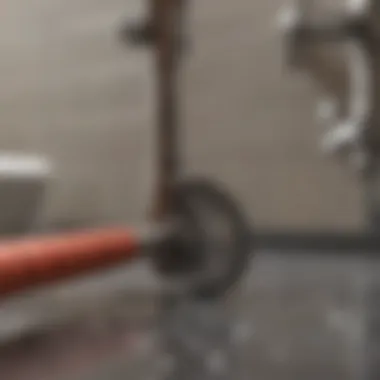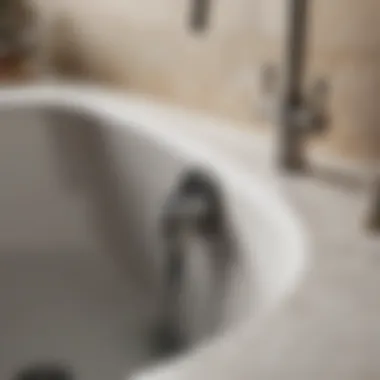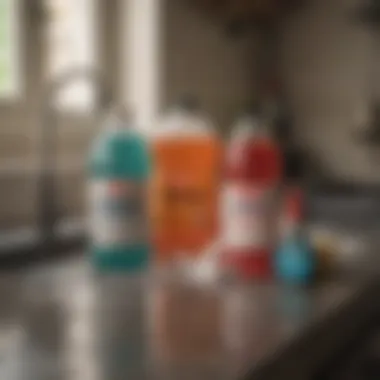Tools to Clear Clogged Drains: An In-Depth Guide


Intro
Clogged drains are a common household issue that can disrupt daily activities and cause significant frustration. Understanding how to effectively tackle these clogs is essential for homeowners and professionals. This comprehensive guide provides insights on tools designed for this specific goal.
Effective resolution of drain clogs often requires more than simple products. It necessitates an understanding of the type of blockage involved. Different clogs require different tools and methods of removal, making it crucial to approach each scenario with a strategic plan.
From manual tools such as plungers to advanced machines like power augers, a variety of options exist to effectively clear drain clogs. Keep in mind that preventative measures, such as routine maintenance and awareness of what can potentially clog drains, play an important role in mitigating this issue.
Additionally, this guide caters to varying levels of expertise, ensuring it is informative for both seasoned plumbers and novice homeowners. Whether you are looking to become more competent in home repair tasks or you are a professional seeking new techniques, clearly understanding the tools available will enhance the way draining issues are resolved.
Let’s explore effective tools for clearing clogged drains, considering their differences, usability, and successful practices to apply in hand.
Understanding Clogged Drains
Clogged drains represent a common but inconvenient issue that many homeowners face. Understanding the dynamics behind clogged drains is crucial, as this knowledge can guide effective problem solving. Clogs can lead to-water backups, unpleasant odours, and even potential damage to plumbing systems. Awareness of the causes and signs of a clogged drain allows one to intervene promptly, avoiding larger issues down the road.
Common Causes of Clogs
Clogs can occur for a variety of reasons. Some of the most common causes include:
- Hair: Hair is one of the leading causes. It typically accumulates over time, matting with soap and other debris.
- Grease: Dumping grease down the sink is common, but that's harmful. It solidifies when it cools, forming significant blockages.
- Food Waste: Small food particles can build up, particularly if proper disposal practices are ignored.
- Foreign Objects: These can include things like toys or feminine hygiene products that accidentally get flushed down toilets or washed down sinks.
Understanding these causes helps in both clearing drains and preventing future clogs. Taking proactive steps can save a great deal of time and hassle later.
Signs of a Clogged Drain
Identifying a clogged drain early can minimize inconvenience. Key signs include:
- Slow Draining: When water drains sluggishly, this indicates a potential clog forming deeper in the pipes.
- Unpleasant Odours: Foul smells emerging from drains usually point toward decomposing food or other organic material trapped inside.
- Gurgling Noises: Unusual sounds, especially when flushing toilets or running faucets, signal that air is trying to escape through a restricted pipe.
Understanding these signs empowers homeowners to act quickly, addressing issues before they escalate.
Proper attention to the way drains operate can avoid complicated plumbing tasks later.
By delving into the causes and symptoms of clogged drains, readers equip themselves with information that enhances their capability to deal with such nuisances effectively.
Basic Tools for Clearing Clogs
Addressing clogged drains effectively requires the right tools. Basic tools are often the first line of defense in tackling drain blockages. They offer homeowners accessibility and initiative when confronted with minor plumbing issues. Knowing how to use these tools can lead to quicker resolutions and potentially save costs associated with professional plumbing services.
Plunger: A Simple Solution
The plunger stands as a classic device in the cleansing of clogged drains. This tool induces pressure, allowing for potential dislodgement of blockages lodged within pipes. Using a plunger is generally straightforward. It exerts an upward and downward motion, creating a vacuum that can shift the debris causing the clog. However, this isn't merely a hit-and-hope exercise. The methodology includes ensuring sufficient water in the sink or toilet bowl to create a seal with the rubber end, thus maximizing efficacy.
"A plunger is not just a tool; it is a first response mechanism in your plumbing arsenal."
It is important to maintain a clean plunger to avoid introducing new bacteria or odors. Proper care will lead to a prolonged lifespan of the device. Additionally, understand that plungers might not effectively clear all types of clogs, particularly those deeper within the plumbing system.
Drain Snake: Versatile and Effective
Drain snakes, also known as augers, offer a distinct advantage when facing stubborn clogs. These devices usually consist of a flexible metal wire wound around a central shaft that can reach significant lengths. Positioning a drain snake correctly and advancing it slowly into a drain can dredge up various materials like hair or grease that often accumulate over time.


When implementing a drain snake, ensuring it's the right type is essential, as different designs serve different purposes. Manual snakes work for small-scale residential use, whereas powered augers may be necessary for larger or more complicated blockages. Knowing the different sizes and mechanisms can be very beneficial.
Some guidelines include:
- Choose an appropriate length based on your drain's location and expected blockage.
- Use slow, steady pressure to promote blockage removal without pushing material further down the drain.
Draining snakes are highly reusable, making them a reliable choice for ongoing maintenance needs. However, they can sometimes displace materials rather than remove them entirely; a follow-up analysis may be necessary.
Chemical Drain Cleaners: Pros and Cons
Chemical drain cleaners present a controversial method in the assortment of tools available. These cleaners employ harsh chemicals formulated to dissolve matter. Common ingredients found in these products include sodium hydroxide and sulfuric acid, which react with the clog. Each product typically brings both benefits and pitfalls.
Pros:
- Fast action can yield immediate results, clearing many types of obstructions virtually instantaneously.
- Often simple to use, requiring minimal guidance.
Cons:
- Frequent use can lead to potential damage of older pipes, resulting in significant long-term complications.
- Harmful substances pose safety risks in terms of exposure or misapplication, with instances of corrosive burns or explosive reactions possible.
When utilizing chemical cleaners, gastral safety measures are paramount. Protective gear, including gloves and goggles, should always be employed. Opting for products specifically designed for the type of clogs you face can reduce negative results.
Manual Techniques for Clog Removal
Manual techniques for clearing clogs are vital components in effective drain maintenance. These methods point to practicality and offer homeowners the ability to address issues without depending on specialized equipment. Understanding these techniques can lead to cost savings and empower individuals to resolve minor plumbing issues independently.
Employing manual techniques require a level of skill and patience. Yet, the benefits can be substantial. They provide immediate, hands-on solutions that often eliminate the need for more invasive methods. Considering simplicity and affordability, various techniques can clear small to moderately clogged drains efficiently.
Using a Plumbing Auger
A plumbing auger, often called a drain snake, is fundamental in manually removing blockages deep within pipes. This sturdy tool consists of a flexible metal coil that enables it to navigate curved or intricate piping systems. However, employing an auger has factors a user needs to consider.
With a plumbing auger, the method is straightforward. First, insert the head of the auger into the drain, with the coil aimed toward the block. Next, you twist and push the handle, allowing the coil to progressively advance deep into the piping. When resistance is felt, it indicates a clogged material. You can then turn the handle counterclockwise, which helps capture debris. This technique targets and dislodges clogs that might be otherwise unreachable.
Despite its utility, incorrect use of an auger can cause damage to the pipes. Individuals must ensure they are familiar with the specific plumbing layout of their homes. This tool also helps prevent downtime, keeping daily functions as uninterrupted as possible.
Effective use of a plumbing auger can free clogs faster than chemical solutions, ensuring more comprehensive drain health.
Homemade Solutions: Vinegar and Baking Soda
Vinegar and baking soda form a popular and eco-friendly solution for clearing minor clogs. This concoction capitalizes on the chemical reaction these two common ingredients produce. It highlights a method accessible to just about any homeowner seeking an alternative to chemical cleaners.
Starting with baking soda, you pour half a cup into the clogged drain, followed by half a cup of vinegar. As these ingredients interact, bubbles form, creating pressure to dislodge built-up gunk. Allow the mixture to sit for at least 15 minutes; longer is preferable for more stubborn bouts of crud. Finally, rinse with hot water to flush remaining residue.
Several homeowners may overlook this method due to its seemingly casual nature. However, properly applying vinegar and baking soda can yield surprisingly effective outcomes without harshness seen in commercial products. Such homemade remedies also emphasize sustainable practices, drawing attention to reducing environmental impact.
These manual techniques provide budget-friendly alternatives that every homeowner needs in their consist defense against plumbing issues. Knowing how to apply them is equal part-knack and understanding; both benefit from frequent practice and awareness.
Advanced Tools for Persistent Clogs
When simple solutions fail to resolve a clog, the need for advanced tools becomes apparent. These methods not only address stubborn blockages but also prevent future issues. Understanding these tools can enhance knowledge about plumbing tasks. In some cases, homeowners may prefer to engage professionals due to the technical nature of these methods, but having awareness is beneficial.
Hydro Jetting: A Powerful Option


Hydro jetting is a service that employs a high-pressure water system to clear clogs and clean the interior walls of pipes. It's particularly effective for grease, sludge, and other materials that traditional techniques might miss. This option is not only powerful but also environmentally friendly. Hydro jetting uses water without reliance on harsh chemicals which often can harm plumbing systems.
The application of high-pressure water can restore the flow efficiency in pipes, significantly extending their lifespan.
Benefits of Hydro Jetting:
- Efficiency: Hydro jetting can alleviate a clog faster than other methods.
- Versatility: It works in various types of pipes including residential and commercial setups.
- Thorough Cleaning: This technique cleans the entire pipe, minimizing future buildup.
- Environmentally safe: It does not introduce harmful chemical substances into plumbing systems.
However, while hydro jetting is effective, it should only be performed by trained professionals. Understanding the requirements and precautions needed before proceeding with this method is crucial, especially in sensitive plumbing networks. Hydro jetting may not be suited for every type of pipe, particularly older or damaged systems where high pressure may cause further harm.
Camera Inspections: Diagnosing the Problem
Camera inspection is aids in accurately pinpointing issues within plumbing systems. A small, flexible video camera is inserted into the pipes, capturing real-time footage. This method is efficient in diagnosing what is causing the clog, be it a physical blockage from large objects or deficiencies along the pipeline like cracks or tree root intrusion.
What to look for with Camera Inspections:
- Physical Blockages: Pinpointing where objects are lodged can help in deciding how to approach clearing the clog.
- Structural Issues: Early identification of pipe damage can save costs building repairs.
- Comprehensive Overview: Offers complete insight into the overall health of the plumbing system.
This method can clear up much of the guesswork often involved in diagnosing a clog. The precise information gathered means homeowners and professionals can choose the appropriate action quickly.
Engagement with the right professional who uses both hydro jetting and camera inspection can minimize the inconvenience from clogged drains effectively. By combining advanced technological tools, comprehensive analysis and efficient clearing solutions, addressing serious plumbing problems becomes seamless.
Safety Considerations
When dealing with clogged drains, safety must be a top priority. Engaging in plumbing tasks without following proper precautions can lead to accidents or injuries. Understanding the safety measures necessary for these tasks can ensure both personal well-being and the successful resolution of plumbing issues.
The tools and chemicals involved in unclogging drains can be hazardous. Observing safety protocols protects not only the individual undertaking the task but also the integrity of the plumbing system and the environment. Knowing how to handle specific tools and chemicals reduces the risk of failure and efficiently clears clogs, minimizing potential damage to plumbing infrastructures.
Protective Gear: Importance and Guidelines
Using protective gear is essential when dealing with clogged drains. This gear not only shields you from contaminants but also guards against injuries caused by tools or chemicals.
Primary Items of Protective Gear Include:
- Gloves: A durable pair of gloves prevents skin contact with dirty water or hazardous chemicals. It is advisable to choose heavy-duty options that resist punctures when using tools such as drain snakes.
- Safety Goggles: Protects the eyes from splashes when pouring chemical cleaners down the drain or in case of tool mishaps.
- Face Mask: Essential when using strong chemical solutions or handling particularly dirty clogs, a mask reduces inhalation of harmful fumes or particles.
- Knee Pads: Useful for added comfort and protection when working at lower levels, such as beneath sinks.
Follow these guidelines to ensure safety while engaging with clogged drains. Always direct attention to wearing the right gear, as neglecting this could have dire consequences today for your health.
Chemical Safety: Handling and Disposal
Chemical drain cleaners are often effective, but they require careful handling and consideration. Familiarize yourself with the risks and best practices associated with these substances to maintain an effective pooling setup.
- Storage: Keep chemicals. in their original containers, securely closed, and out of children’s reach. Store them in a cool, dry place to prevent them from degrading or causing reactions.
- Handling: Always read labels before use. Gloves and eyewear should be essential. Moreover, work in a well-ventilated area to minimize inhalation of toxic fumes.
- Disposal: Dispose of any unused or expired chemical cleaners according to local regulations. Many areas have specific disposal guidelines or collection sites to avoid environmental contamination.
Important: Always consult local regulations for specific disposal methods. Adhering to these guidelines will help you handle and dispose of chemicals safely, contributing to a cleaner environment and a safer plumbing experience.
By prioritizing protective gear and chemical safety, you counter the inherent risks associated with drain cleaning tools and methods. These practices provide essential knowledge that every homeowner should possess to protect oneself from hazards.
Preventative Measures for Clogged Drains
Preventing clogged drains is often easier and more cost-effective than resolving them after they occur. Homeowners can take various steps to ensure a smoother plumbing experience. Prioritizing preventive measures not only saves time but also avoids the expense of professional intervention. Understanding what leads to clogs can significantly aid in taking the right precautions.
Regular Maintenance Tips


Regular maintenance is fundamental in preventing clogged drains. Here are several practical steps:
- Use Drain Screens: Installing screens over drains can catch hair and debris before they enter pipes.
- Routine Inspection: Regularly check sink traps and bathtub drains for any accumulated materials. Remove build-up as necessary.
- Flush with Hot Water: Periodically flushing drains with boiling water can help clear out smaller debris before it becomes a problem.
- Bi-Annual Cleaning: Planning for a professional drain cleaning every six months can keep your plumbing in good shape. Such measures help in avoiding unexpected clogs.
Proper Disposal Practices
Proper disposal is critical in keeping drains clear. Understanding what to throw away helps prevent build-up:
- Limit Grease Disposal: Never pour cooking oils or grease down the sink. They can solidify and cause significant clogs.
- Food Waste Management: Use garbage disposals correctly, and avoid putting large or fibrous food scraps down them.
- Toilet Etiquette: Be mindful of what goes into toilets. Only human waste and toilet paper should be flushed.
- Plan for Hazardous Waste: Chemicals and toxic substances should be disposed of according to local regulations, never through drains.
Preventative measures are the bedrock of a well-functioning plumbing system. Consistent vigilance can lead to translations of inconvenience into postponed yet manageable tasks.
By following these guidelines, property owners can minimize their risk for future issues. Investing sproper practices aids turning prevention into a part of home maintenance routines.
When to Call a Professional
When dealing with clogged drains, there comes a moment when DIY efforts may not suffice. Understanding what those moments are is crucial for home and property maintenance. Knowing when to call a professional not only preserves the integrity of plumbing systems but can also save homeowners from further complications and costs down the line.
Clogged drains can manifest in various ways, from slow drainage to complete blockages. In some instances, the efforts one can employ might be inadequate, heightening the urgency to seek expert assistance. Recognizing serious problems is seldom straightforward. Many indicators reflect underlying issues that necessitate a professional's insight. Inadequate solutions to recurrent clogs could hint at substantial complications, like a damaged pipe or tree-related blockage.
Identifying Serious Problems
It is essential to be attentive to the signs that suggest a problem has moved beyond your capability to handle. Some obvious signals include:
- Recurrent Clogs: If a drain clogs repeatedly. This may indicate a more profound issue within the plumbing system.
- Unpleasant Odors: Constant foul smells emanating from your drains can signal serious blockages or materials decomposing in hard-to-access parts of the plumbing.
- Sewage Overflow: Any overflow connecting to your home’s sewage must be treated as an emergency. This calls for specialized tools and expertise.
Also, consider the duration of the issues. A simple plunger might alleviate temporary clogs. If the problem persists for days or even weeks, engaging a professional can provide clarity and resolution. Hidden complexities may be causing minimal inconveniences, yet escalating inconveniences.
"Ignoring a stubborn drain issue often leads to higher repair costs later on."
Early intervention can be beneficial. Realizing the pattern of what lies beneath repeated clogs is paramount. Experienced professionals employ advanced tools to locate damages and can quickly assess whether it is a minor blockage requiring unclogging or a serious pipe dilemma needing repair or replacement.
Finding Qualified Help
Finding the appropriate help may seem daunting. Not only is it necessary to identify a qualified plumber, but establishing their reputation is vital.
- Research Online: Utilize credible websites and community forums like Reddit for first-hand reviews and discussions about local plumbers. Websites like Wikipedia or Britannica can help understand plumbing topics better.
- Ask for Recommendations: Inquire with neighbors and colleagues. Insights from trusted sources can carry more weight than online reviews.
- Verify Credentials: Always check if the plumbers are licensed and insured. This validates their competency and protects you against liabilities.
Before committing to professional help, don’t shy away from inquiring about expected costs and timeline. Establish clear communication to set expectations, ensuring the scope of work and potential solutions align with both excitement and concerns of the operation.
In conclusiun, recognizing when to turn to a professional service can significantly improve your plumbing experience, preventing minor issues from spiraliny into extensive damage. Acknowledging signs and knowing how to locate competent assistance forms a key part of effective plumbing maintenence.
Finale
In finally concluding this guide, it is essential to acknowledge the significance of utilizing the right tools and methods for clearing clogged drains. Each step outlined throughout the article is critical, not only for troubleshooting specific issues but also for enhancing the long-term use of plumbing systems. Regular attention to drain maintenance allows for minimized problems over time, while understanding when to employ both manual tools and more advanced machinery can save both time and money.
The selection of appropriate tools, such as plungers or drain snakes, emphasizes a fundamentally practical approach. This positions homeowners in a proactive role, allowing them to tackle minor clogs before they escalate. However, recognizing the signs of serious problems is equally pivotal. Homeowners must understand when to shift gears from self-reliant measures to invoking professional help. Effective communication with skilled technicians can often provide insight and peace of mind.
The right tools can transform the daunting task of clearing drains into a manageable activity.
Delivery of insights on chemical cleaners, safety considerations, and preventative tips encapsulates the balance between efficiency and safety. By combining technical knowledge with mindfulness of hazards associated with plumbing work, homeowners ensure a sustainable and safe outcome.
In essence, the study of tools to clear clogged drains offers vital lessons in responsibility and preparedness. Emphasizing foresight in the care of plumbing systems will ultimately lead to superior living environments and increased property values.
Summary of Key Insights
- Understanding of Common Clogs: Knowing the typical culprits behind clogged drains allows homeowners to intervene effectively and timely.
- Key Tools: Basic tools, such as the plunger and drain snake, offers immediate solutions for minor clogs, while advanced tools deal with severe blockages.
- Safety First: Protective gear and being cautious with chemicals prevent accidents and health risks in plumbing tasks.
- Professional Help: Identifying serious plumbing issues and knowing when to involve professionals is necessary to prevent further damage and expense.
- Preventative Measures: Regular maintenance and proper disposal practices reduce the likelihood of future problems, contributing to an efficient household plumbing system.
In wrapping up, these insights offer readers the fundamental knowledge necessary for managing clogged drains effectively, promoting a better grasp of both immediate actions and longer-term strategies in home maintenance.



